The Blue Mosque (Sultanahmet) in Istanbul
The Blue Mosque, also known as Sultanahmet Mosque or Sultan Ahmet Camii, stands as one of Turkey’s most remarkable historical places, and a symbol of Istanbul’s rich history. With its breathtaking architecture and spiritual significance, the Blue Mosque is a must-visit destination for travelers from all over the world. In this article, we will delve into the fascinating story of this majestic mosque, exploring its history, unique features, and practical information for visitors.
Table of Contents
Blue Mosque and Its Significance

The Blue Mosque, officially named Sultan Ahmed Mosque after its founder Sultan Ahmed I, was built between 1609 and 1616 during the Ottoman Empire. The mosque’s striking blue-hued tiles that adorn its interior walls give it the nickname “Blue Mosque” and contribute to its enchanting ambiance. This masterpiece of Ottoman architecture was commissioned as a grand imperial mosque, showcasing the power and wealth of the Ottoman Empire at the time.
Today, the Blue Mosque serves as both an active place of worship and a major tourist attraction. Its soaring domes, six elegant minarets, and stunning courtyard make it a sight to behold. Visitors are welcomed to experience the tranquility and spirituality of this historic mosque, which has become an integral part of Istanbul’s cultural heritage.
the Blue Mosque’s history is intertwined with that of the Hagia Sophia, another iconic monument of Istanbul. Hagia Sophia, initially constructed as a cathedral in the Byzantine era, was later converted into a mosque during the Ottoman period. The Blue Mosque, built several centuries later, reflects elements inspired by the Hagia Sophia, demonstrating the influence of Byzantine architecture on Ottoman design.
The Blue Mosque stands as a testament to the grandeur and artistic brilliance of the Ottoman Empire, offering visitors a glimpse into the past and a connection to the spiritual heritage of Turkey. As we delve deeper into its history and features, you will come to appreciate the Blue Mosque’s significance as one of Istanbul’s most beloved and awe-inspiring landmarks.
History of the Blue Mosque

The construction of the Blue Mosque began in 1609 during the reign of Sultan Ahmed I, and it took seven years to complete, with its doors opening to the public in 1616. The master architect behind this architectural marvel was Mehmet Ağa, a talented disciple of the renowned Ottoman architect, Mimar Sinan. Mehmet Ağa’s expertise and vision brought to life the grandeur and elegance that define the Blue Mosque.
The construction of the Blue Mosque was not merely an architectural endeavor; it held significant political and symbolic importance. Sultan Ahmed I, determined to make a bold statement of Ottoman power and piety, envisioned a mosque that would rival the grandeur of the Hagia Sophia, which stood nearby. As a result, the Blue Mosque was designed to be larger and more impressive than any other mosque of its time, showcasing the empire’s prosperity and religious devotion.
Purpose of the Mosque and Its Relation to the Hagia Sophia
The Blue Mosque was intended to serve as an imperial mosque, primarily for the Sultan and his court, as well as a place of worship for the general public. It was strategically constructed near the Hagia Sophia, which was then a mosque after the Ottoman conquest of Constantinople. The proximity of the Blue Mosque to the Hagia Sophia holds historical significance, symbolizing the replacement of one dominant religious structure with another.
Moreover, the mosque’s strategic location in the heart of Istanbul, overlooking the historic Sultanahmet Square, adds to its allure and accessibility for both locals and tourists. The Blue Mosque’s harmonious coexistence with the Hagia Sophia exemplifies Istanbul’s rich history, where diverse cultural influences merge to create a mesmerizing tapestry.
Unique Architectural Features
The Blue Mosque’s architectural brilliance is evident in its unique design elements. The most prominent feature is the presence of six minarets, an unprecedented move at the time, which led to a legendary tale. According to the story, the Sultan requested “altın minare” (golden minarets) from the architect, but due to a misunderstanding, the architect built “altı minare” (six minarets). To remedy this, Sultan Ahmed I commissioned the construction of a seventh minaret at the Mecca’s Masjid al-Haram, so they would match in number.
Inside the mosque, visitors are captivated by the grandeur of the central dome, which stands at an impressive height of 43 meters (141 feet). The dome is adorned with more than 20,000 delicate Iznik tiles, handcrafted with intricate floral patterns in beautiful shades of blue and green, hence the name “Blue Mosque.” The interior also features magnificent stained-glass windows, bathing the prayer hall in colorful hues during daylight.
The Interior Decoration
Stepping inside the Blue Mosque is like entering a treasure trove of artistic beauty. The walls are lined with exquisite Iznik tiles, each handcrafted with precision and care. These tiles, produced in the town of Iznik during the 16th and 17th centuries, are renowned for their vibrant colors and detailed designs, ranging from floral motifs to intricate geometric patterns. The splendid combination of blue, turquoise, and white tiles creates an enchanting atmosphere, offering a unique visual feast for visitors.
UNESCO World Heritage Site
The Blue Mosque’s historical and cultural significance has earned it the prestigious title of a UNESCO World Heritage Site. This designation recognizes its outstanding universal value and the need for its preservation for future generations. As one of Istanbul’s most treasured landmarks, the Blue Mosque continues to inspire awe and admiration, drawing travelers from all corners of the globe to experience its captivating beauty and spiritual ambiance.
Interesting Facts about the Blue Mosque
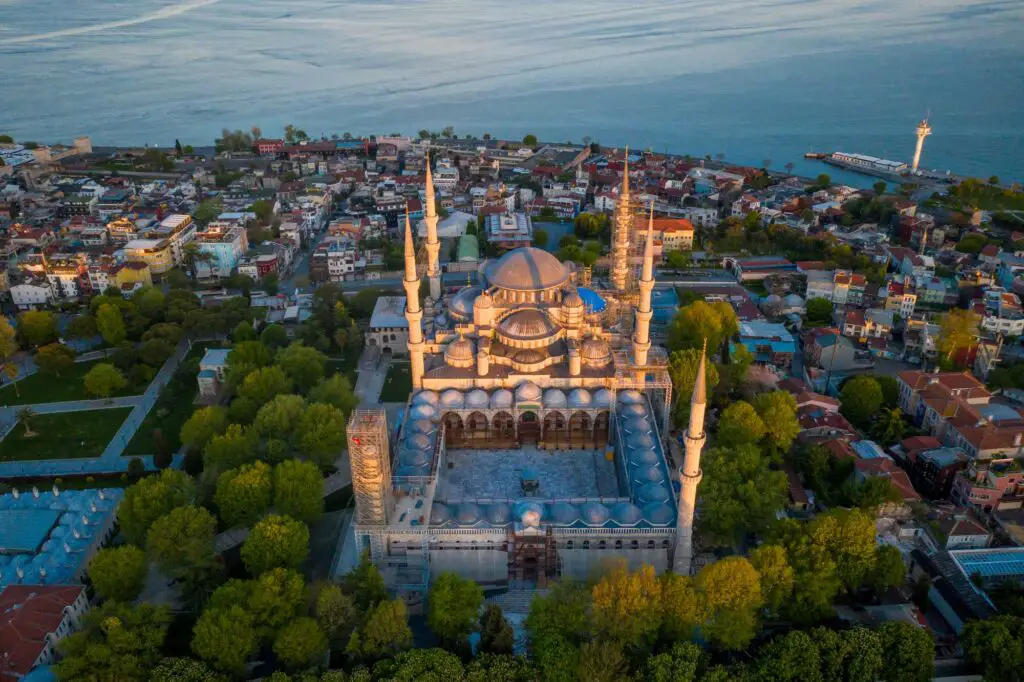
The construction of the Blue Mosque began in 1609 during the reign of Sultan Ahmed I, and it took seven years to complete, with its doors opening to the public in 1616. The master architect behind this architectural marvel was Mehmet Ağa, a talented disciple of the renowned Ottoman architect, Mimar Sinan. Mehmet Ağa’s expertise and vision brought to life the grandeur and elegance that define the Blue Mosque.
The construction of the Blue Mosque was not merely an architectural endeavor; it held significant political and symbolic importance. Sultan Ahmed I, determined to make a bold statement of Ottoman power and piety, envisioned a mosque that would rival the grandeur of the Hagia Sophia, which stood nearby. As a result, the Blue Mosque was designed to be larger and more impressive than any other mosque of its time, showcasing the empire’s prosperity and religious devotion.
The Presence of Six Minarets and the Legend Behind It
One of the most intriguing features of the Blue Mosque is the presence of six minarets, a rarity among mosques of its time. The legend surrounding these minarets adds an enchanting touch to the mosque’s history. As mentioned earlier, when Sultan Ahmed I requested “altın minare” (golden minarets) from the architect, Mehmet Ağa, the architect misunderstood and constructed six minarets instead. This resulted in a unique situation as the only other mosque with six minarets was the revered Masjid al-Haram in Mecca.
Comparison with the Prophet's Mosque in Mecca and the Addition of a Seventh Minaret
Upon learning that the Blue Mosque had the same number of minarets as the Masjid al-Haram, Sultan Ahmed I took action to distinguish the two. In a remarkable show of piety and reverence for the Prophet’s Mosque, he commissioned the construction of a seventh minaret at the Masjid al-Haram. This act not only set the Blue Mosque apart but also demonstrated the Sultan’s devotion to Islam and respect for the holy sites in Mecca.
The Only Mosque in Istanbul with Six Minarets
The Blue Mosque’s status as the only mosque in Istanbul with six minarets elevates its significance and allure. The six slender minarets gracefully punctuate the skyline, bestowing a sense of grandeur upon the mosque. Each minaret is adorned with balconies and distinct architectural details, reflecting the Ottoman design aesthetic. These minarets serve both a practical and symbolic purpose, providing the call to prayer (adhan) and representing the mosque’s link to Islamic heritage.
The Blue Mosque’s six minarets have become an iconic symbol of Istanbul and are widely recognized across the world. As the sunlight reflects off their elegant domes, the minarets create a stunning visual spectacle, especially during the evening “Blue Hour.” Visitors are captivated by the mesmerizing sight, as the mosque’s silhouette is beautifully outlined against the backdrop of Istanbul’s scenic skyline. The Blue Mosque’s architectural magnificence and cultural significance continue to leave an indelible mark on those fortunate enough to experience its splendor firsthand.
Sultanahmet square and around
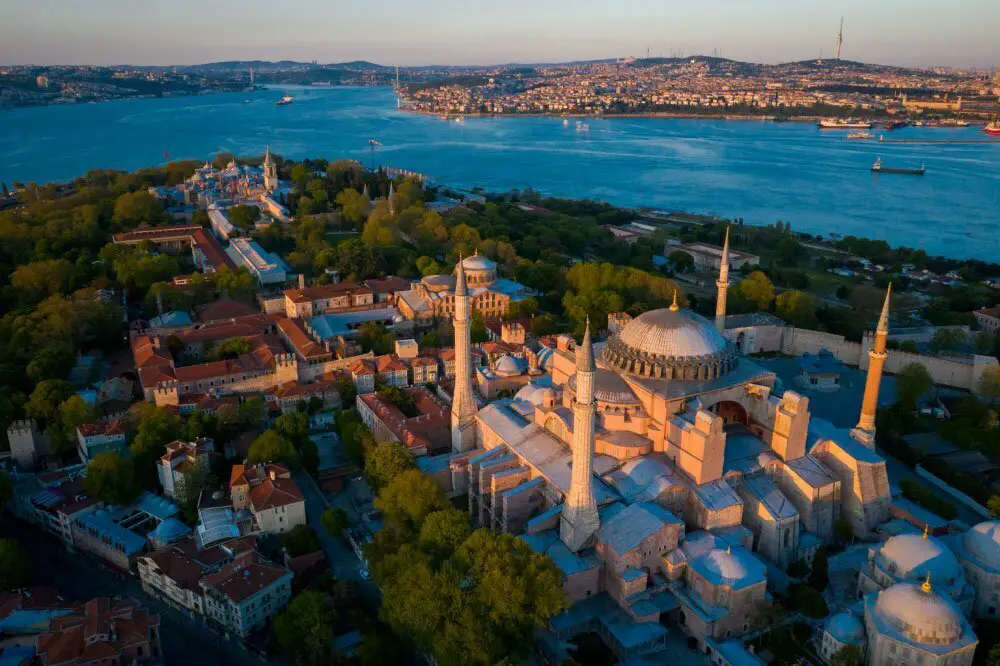
The Blue Mosque’s location in Sultanahmet Square makes it a focal point of historical and cultural significance in Istanbul. The square, also known as Hippodrome in ancient times, offers a treasure trove of attractions just waiting to be explored by travelers. One such landmark adjacent to the Blue Mosque is the awe-inspiring Hagia Sophia, a former Byzantine cathedral and Ottoman mosque, now a mesmerizing museum. Its majestic dome and rich history make it a must-visit destination for history enthusiasts.
Within walking distance from the Blue Mosque, you’ll find the splendid Topkapi Palace, the opulent residence of Ottoman Sultans for centuries. Step into the lavish world of the Sultans as you explore its ornate courtyards, opulent chambers, and fascinating exhibitions of artifacts, including the Prophet Muhammad’s cloak and sword.
For those seeking to dive into Istanbul’s bustling bazaars, the Grand Bazaar awaits nearby. This labyrinthine marketplace entices visitors with its vibrant colors, aromatic spices, and a plethora of unique souvenirs, textiles, and handcrafted items.
How to Get to the Blue Mosque
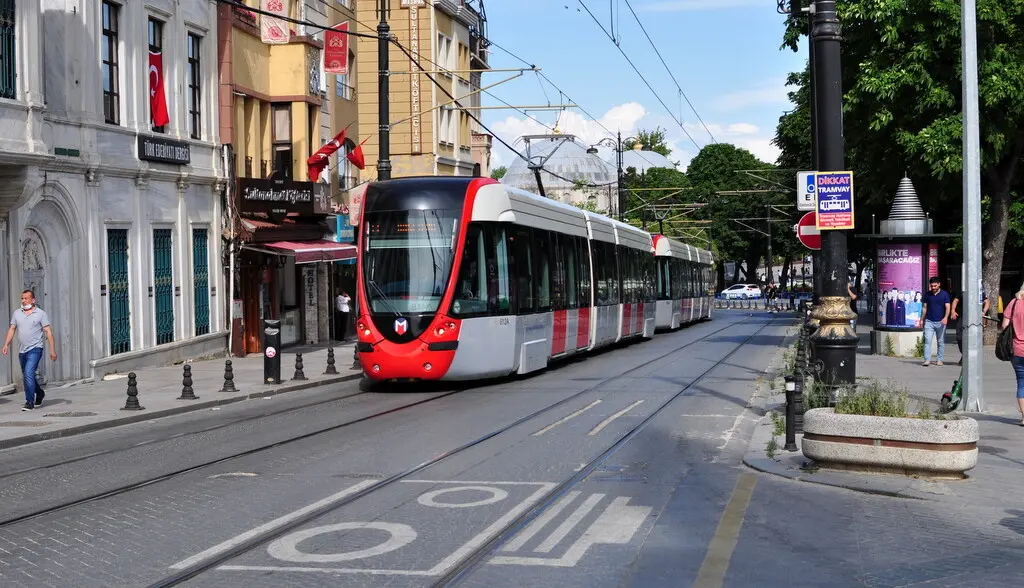
The Blue Mosque’s central location in Istanbul’s historic Sultanahmet district makes it easily accessible for both locals and travelers. Here are some convenient ways to reach this iconic landmark:
A. Take the Tram to Sultanahmet: Using Istanbul’s efficient tram system is one of the most convenient ways to get to the Blue Mosque. If you’re staying in the modern part of the city or any other area served by the tram, you can hop on the T1 line and alight at the Sultanahmet stop. From there, it’s just a short walk to the Blue Mosque.
B. Short Walking Distance: Once you arrive in Sultanahmet, reaching the Blue Mosque is a pleasant and straightforward stroll. The mosque is located right in the heart of the district, surrounded by historic sites and charming streets. Follow the signs or simply ask friendly locals for directions, and you’ll find yourself standing before the grand entrance of the Blue Mosque in no time.
C. Potential Queues During Busy Periods: As one of Istanbul’s most popular attractions, the Blue Mosque can experience significant crowds, especially during peak tourist seasons. It’s advisable to plan your visit during less busy times to enjoy a more tranquil experience. Early mornings or late afternoons are generally less crowded, allowing you to explore the mosque’s beauty at a leisurely pace.
Proximity to Other Attractions:
One of the advantages of visiting the Blue Mosque is its close proximity to other captivating attractions. After marveling at the mosque’s exquisite architecture and serene atmosphere, take the opportunity to explore nearby gems. The magnificent Hagia Sophia, the splendid Topkapi Palace, and the vibrant Grand Bazaar are all within walking distance. Immerse yourself in the rich history and culture of Istanbul as you embark on a captivating journey through these remarkable landmarks.
Remember to dress modestly when visiting the Blue Mosque, as it is an active place of worship. Respectful attire, such as covering shoulders and knees, is appreciated out of consideration for the mosque’s significance to the local community. With a spirit of curiosity and appreciation, your visit to the Blue Mosque and its surroundings will undoubtedly be a cherished highlight of your time in Istanbul.
Entrance, Tickets, and Tours
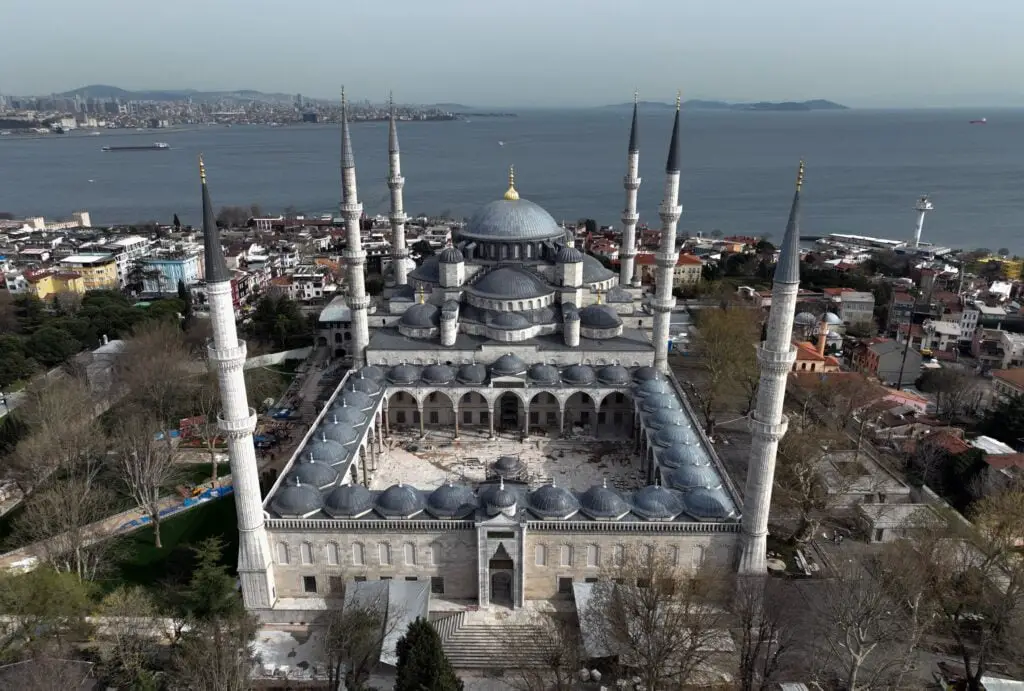
The Blue Mosque warmly welcomes visitors from all around the world, and one of the best parts is that there is no entrance fee to experience its grandeur. As a significant religious and historical site, the mosque offers free admission to all, allowing everyone to admire its architectural splendor and immerse themselves in the spiritual atmosphere.
It’s important to note that while the Blue Mosque offers free entrance, the Istanbul Museum Card, which grants access to multiple museums and attractions in the city, is not valid for entry to this iconic landmark. Since the Blue Mosque is an active place of worship, it operates separately from the museum system in Istanbul.
With its free admission and the option for guided tours, the Blue Mosque ensures that visitors can experience its beauty and cultural significance in a manner that suits their preferences. Whether you choose to explore independently or join a guided tour, the Blue Mosque promises an enchanting journey through time and spirituality, leaving you with lasting memories of your visit to this architectural masterpiece in the heart of Istanbul.
Visitor Information
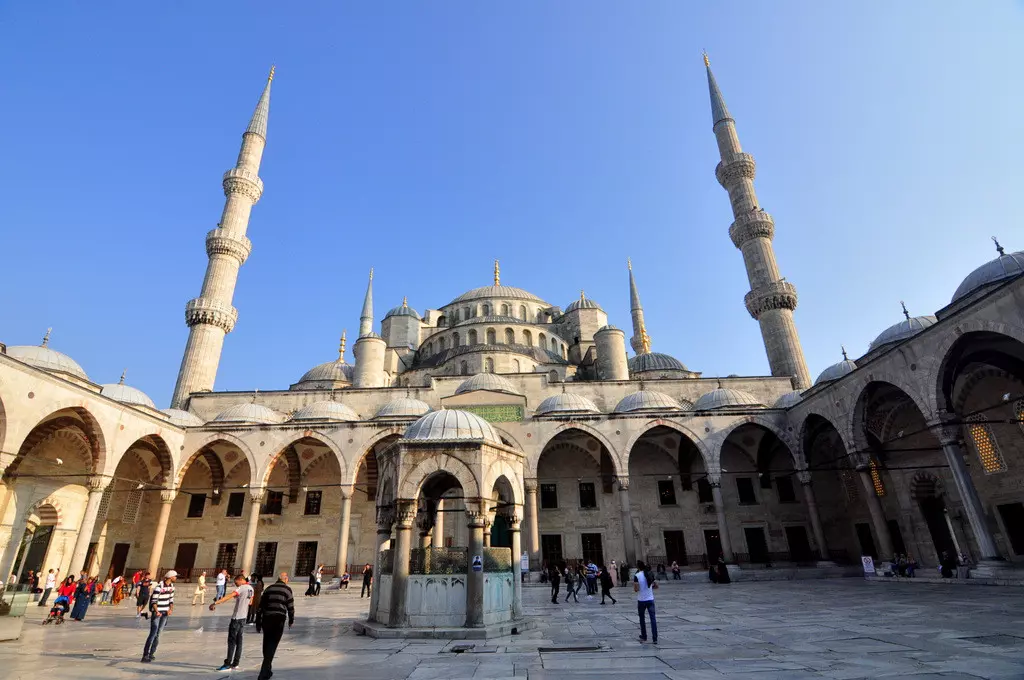
A. Mosque’s Status as a Working Mosque and Restrictions During Prayer Time: The Blue Mosque, also known as Sultanahmet Mosque, is not only a historical marvel but also a functioning place of worship. As such, it holds great religious significance for the local Muslim community. While visitors are welcomed to explore the mosque’s stunning architecture and learn about its history, it’s essential to remember that the mosque is in use for daily prayers and special religious events.
During prayer times, which occur five times a day, the mosque is closed to tourists. These prayer times are an integral part of the Islamic faith and are strictly observed. As a visitor, it’s essential to be respectful of the worshippers’ religious practices and avoid entering the mosque during prayer hours. Signs outside the mosque and announcements made by the staff will indicate the prayer times for the day.
B. Recommended Dress Code and Availability of Garments at the Entrance: When visiting the Blue Mosque, it’s crucial to dress modestly and respectfully, out of consideration for the religious significance of the site. Both men and women should ensure that their attire covers their shoulders and knees. Women are also required to cover their heads with a scarf as a mark of respect while inside the mosque.
If you arrive at the mosque without appropriate clothing, there’s no need to worry. Complimentary garments are provided at the entrance for both men and women to borrow during their visit. These garments are available for visitors to use to cover their shoulders, legs, and heads. It’s a wonderful gesture that enables everyone to experience the beauty of the Blue Mosque without any concern about the dress code.
C. Opening Hours and Peak Times to Consider: The Blue Mosque is open for visitors every day, except during prayer times. The specific opening hours may vary, but generally, it is accessible in the morning after the first prayer of the day until the late afternoon. It’s advisable to check the mosque’s official website or contact the staff for the most up-to-date information on opening hours.
As one of Istanbul’s most popular attractions, the Blue Mosque can get crowded, especially during peak tourist seasons. To enjoy a more peaceful and serene experience, consider visiting early in the morning or later in the afternoon. This allows you to appreciate the mosque’s beauty in a tranquil atmosphere and take stunning photos without the bustling crowds.
By following these guidelines and being mindful of the mosque’s religious significance, you can ensure a respectful and enjoyable visit to the Blue Mosque, a true architectural marvel and spiritual sanctuary in the heart of Istanbul.
Accommodation Options

Hotels in the Vicinity:
For travelers planning to visit the Blue Mosque and explore the historical wonders of Sultanahmet, there are numerous accommodation options catering to various budgets. Whether you prefer luxury hotels, cozy boutique stays, or budget-friendly hostels, you’ll find something that suits your needs and preferences.
In the immediate vicinity of the Blue Mosque, you’ll discover charming boutique hotels that offer an authentic experience with traditional Turkish hospitality. These smaller hotels often feature Ottoman-inspired decor, creating a sense of immersion in Istanbul’s rich cultural heritage. Additionally, many of these boutique establishments are within walking distance of other popular attractions, such as the Hagia Sophia, Topkapi Palace, and the Grand Bazaar, making them convenient bases for sightseeing.
Luxury Hotels:
If you’re seeking a lavish experience and a taste of opulence during your stay in Istanbul, several luxurious hotels surround the Sultanahmet area, offering unparalleled comfort and breathtaking views. Among these, the Four Seasons Sultanahmet stands out as a remarkable choice. Situated just a stone’s throw away from the Blue Mosque, this five-star hotel exudes elegance and sophistication. The Four Seasons boasts a stunning rooftop terrace, where you can enjoy a delightful breakfast while gazing at the minarets of the Blue Mosque.
Another exceptional option for those seeking luxury is the Armada Sultanahmet. Nestled in a historic building, this boutique hotel provides a perfect blend of modern amenities and Ottoman-inspired design. From its rooftop terrace, you can relish mesmerizing views of the Blue Mosque and the Sea of Marmara, creating a truly unforgettable experience.
When choosing your accommodation, keep in mind the proximity to the attractions you plan to visit and the level of luxury that suits your preferences. Whether you opt for a boutique hotel with a traditional touch or a lavish experience at one of Istanbul’s finest luxury hotels, the Sultanahmet area offers a range of choices to ensure a memorable and enjoyable stay during your visit to the Blue Mosque and the captivating city of Istanbul.